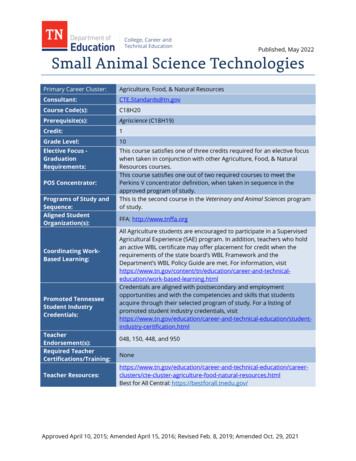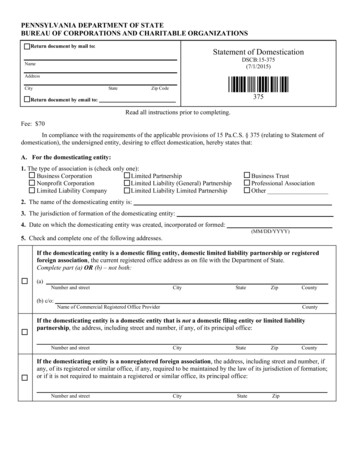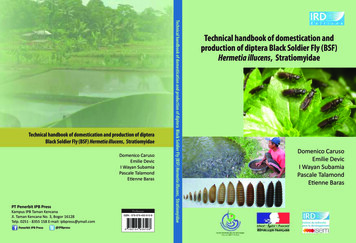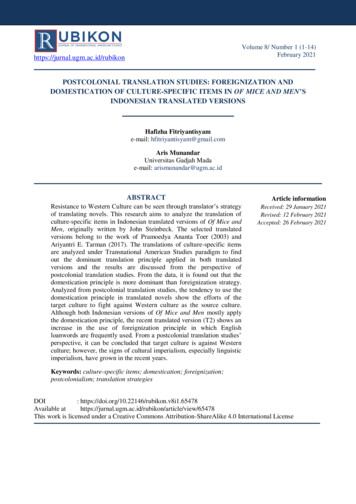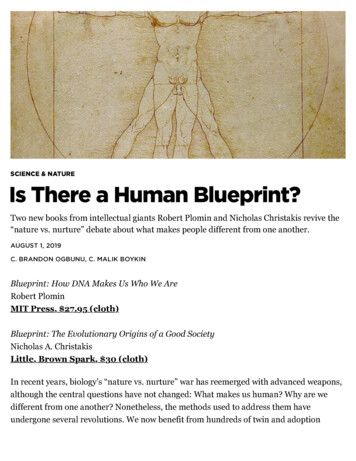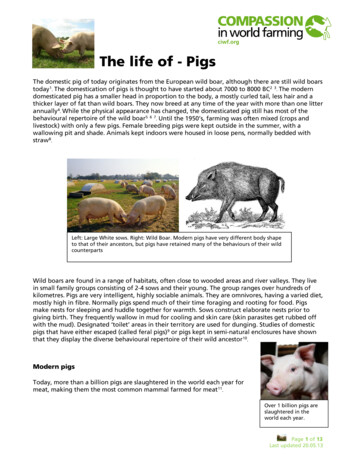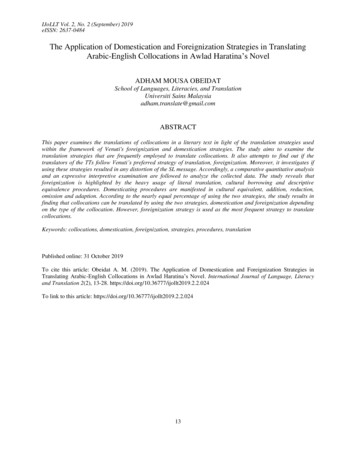
Transcription
IJoLLT Vol. 2, No. 2 (September) 2019eISSN: 2637-0484The Application of Domestication and Foreignization Strategies in TranslatingArabic-English Collocations in Awlad Haratina’s NovelADHAM MOUSA OBEIDATSchool of Languages, Literacies, and TranslationUniversiti Sains Malaysiaadham.translate@gmail.comABSTRACTThis paper examines the translations of collocations in a literary text in light of the translation strategies usedwithin the framework of Venuti's foreignization and domestication strategies. The study aims to examine thetranslation strategies that are frequently employed to translate collocations. It also attempts to find out if thetranslators of the TTs follow Venuti’s preferred strategy of translation, foreignization. Moreover, it investigates ifusing these strategies resulted in any distortion of the SL message. Accordingly, a comparative quantitative analysisand an expressive interpretive examination are followed to analyze the collected data. The study reveals thatforeignization is highlighted by the heavy usage of literal translation, cultural borrowing and descriptiveequivalence procedures. Domesticating procedures are manifested in cultural equivalent, addition, reduction,omission and adaption. According to the nearly equal percentage of using the two strategies, the study results infinding that collocations can be translated by using the two strategies, domestication and foreignization dependingon the type of the collocation. However, foreignization strategy is used as the most frequent strategy to translatecollocations.Keywords: collocations, domestication, foreignization, strategies, procedures, translationPublished online: 31 October 2019To cite this article: Obeidat A. M. (2019). The Application of Domestication and Foreignization Strategies inTranslating Arabic-English Collocations in Awlad Haratina’s Novel. International Journal of Language, Literacyand Translation 2(2), 13-28. https://doi.org/10.36777/ijollt2019.2.2.024To link to this article: https://doi.org/10.36777/ijollt2019.2.2.02413
IJoLLT Vol. 2, No. 2 (September) 2019eISSN: 2637-0484INTRODUCTIONTranslation strategies play a vital role in translating cultural collocations. Due to the significanceof translation strategies, scholars theorized and developed different translation strategies such asthose suggested by Newmark (2001), Nida (1964) and Venuti (1995). Translation is a process oftransferring meaning from one language into another. Oxford Advanced Learner's Dictionary(2005) defines translation as “the procedure of transferring something that is spoken or writteninto another language. From this definition, the translation process looks an easy process as itindicates to replace words by words. However, the difficulty of translation arises from the cultureor style substitution which cannot be achieved by only replacing words. Nida (1969) states thattranslation as a process includes the terms of meaning and style as the goal is to reproduce thenatural equivalence of the source language message to the target language.The term collocation was first introduced by Firth, who believes that the meaning ofcollocation is completely lexical (Firth, 1957, p. 195). For him, the lexical meaning is one of fivedimensions of meaning (phonetic, lexical, semantic, morphological and syntactic) (p. 196).Oxford Advanced Learner’s Dictionary (2005) defines 'collocation' as "a combination of wordsin a language that happens very often and more frequently than would happen by chance:‘resounding success’ and ‘crying shame’ are English collocations" (p. 293). Gledhill (2000)defines collocation as "a process by which words combine into larger chunks of expression.Some collocations involve words which seldom occur in other combinations" (p. 9).The translator of literary works needs not only to be bilingual but also, he/she should have adeep knowledge of the different implications and impacts of the cultural elements used in aliterary text. Toury (1995, p. 56) describes translation of literature as an activity which‘inevitably involves at least two languages and two cultural traditions, i.e. at least two sets ofnorm-systems on each level’ A Collocation in a literary text is used as a way of reflecting theculture of the ST, in addition to the reflection of the language use. Such language use includesthe way to express figurative meaning as قيد انملة in Arabic, which equivalently means an inch inEnglish. In this regard, Kalėdaitė, & Palevičienė, (2008) argue that “differences in collocationalpatterning in different languages reflect the preferences of specific language communities forcertain modes of expression. Some collocations are a direct reflection of the material, social, ormoral environment in which they occur. This explains, for example, why bread collocateswith butter in English, but not in Arabic (p. 88). Since collocations are used naturally by thespeakers of any language, then they have important functions to make the text more cohesive, toclearly convey the writer's intention and to create new figurative images to the reader.The variety of different lexical items that occur together in a literary text makes theirtranslation challengeable as some combinations of words may have a meaning that differs fromthe meaning of the individual word. A literal translation of such collocation may result inmeaning loss or mistranslation of collocation, for example, فلذة الكبد should not be translated as apart of a lever. Such literal translation destroys the meaning completely, in addition to makingsuch translation looks odd for target readers. Thus, translators need to pay more attention to theprocedures of translating collocations to avoid making the collocation look odd to the receptorreaders and to make it appear as a natural impression. However, literal translation succeeds, insome cases, to render the open-ended collocations which have no intended meaning such as بدأت ( الحرب the war started). The meaning of such collocation can be obtained from the dictionarymeaning of the collocation components.14
IJoLLT Vol. 2, No. 2 (September) 2019eISSN: 2637-0484By investigating cultural collocations in a literary work and its translation, the present studyaims to apply the strategies of domestication and foreignization to the selected collocations andexamining if those collocations are domesticated or foreignized in the target texts. Theresearchers apply Venuti's (1995) model of domestication and foreignization to investigate theprocedures that are employed to domesticate or foreignize collocations. The study also aims atfinding if collocations in the literary text should be domesticated or foreignized to achieve thebest equivalence in the target text (TT). In other words, the objective is to shed light oncollocation translation as an attempt to bridge the gap between the two languages subject of thispaper i.e. Arabic and English.LITERATURE REVIEWVenuti (1995) believes that the domestication strategy is a strategy that deals with culture. Hedivides this strategy into two main steps, first, to choose a foreign text or a cultural element ofthis text, and second, to find an adequate translation method to convey this cultural element intothe target text. In this strategy, what is domesticated is the form and content. On the contrary,foreignization follows the same steps of the domestication strategy. However, what isforeignized is only the content, while the form is mostly domesticated.Venuti’s model is based on the different methods of translation suggested by Schleiermacher,who believes that "in translation, the translator either leaves the author in peace, as much aspossible, and moves the reader towards him, or he leaves the reader in peace and moves theauthor towards him" (Schleiermacher, 1813, cited in Venuti, 1995, p. 19).According to Venuti (1995) domestication is "an ethnocentric reduction of the foreign text toreceive cultural values, bringing the author back home" (p.20), whereas foreignization is "anethno deviant pressure on those values to register the linguistic and cultural differences of theforeign text, sending the reader abroad" (Venuti, 1995, p. 20). He prefers to use foreignization asa strategy of translating cultural texts due to the need to “signify the linguistic and culturaldifferences of the foreign text” (p. 23). Moreover, this strategy can change how translation isconceived and created since it implies the notion of human subjectivity that differs from thehumanist assumptions involved in domestication (Venuti 1995 as cited in Obeidat & AbuMelhim, 2017 p. 53).Indeed, translating collocations from Arabic into English is not an easy task since they havetheir own characteristics in language use, word choice, cultural concepts, idiomatic meaning andso forth. Accordingly, when a literary text is translated into the target language certain factorsshould be taken into consideration. As the source text of this study is translated for the purposeof literature and transferring the source text (ST) culture into TT culture, translators have to paymore attention to the collocations in terms of word choice and cultural signs. Many translatedliterary texts suffer in quality due to linguistics, semantic, pragmatic or stylistic errors.Munday (2001) defines the domestication strategy as a type of translation, where the elementsof the ST foreign elements are reduced into the receiving language cultural values (p. 225). Onthe other extreme, foreignization is illustrated by keeping the foreign values of the source text inthe translated version (Shuttelworth & Cowie, 1997, p. 59). An example of the differencebetween the two concepts in the two languages subjects of this study is the collocation, يغض ( الطرف Yaghudu al-Tarf) which literally means: ignoring something / someone. To domesticatethis collocation into English, a translator may use the procedure of dynamic equivalence and15
IJoLLT Vol. 2, No. 2 (September) 2019eISSN: 2637-0484translate it into "turned a blind eye". Any other translation of these collocations, such as theliterally on, will be the foreignization strategy, for example, lower his eyebrows.Yang (2010) comments that "domestication and foreignization are two basic translationstrategies which provide both linguistic and cultural guidance for the translator in renderingcultural- specific source texts into parallel target texts" (p. 1). Obeidat and Mahadi (2019) arguethat “domestication and foreignization are two important strategies in translating culturalcollocations” (p. 155). Moreover, Munday (2001) states that "domestication and foreignizationanswer the question of how to bridge the gulf that had grown between the writer or the sourcetext which is written in a language that is very culture-bound and the target- text writer" (p. 242).Thus, the debate of these two strategies is not about the linguistic form. They expand beyond thelinguistic boundaries to be more concerned with cultures (Sharifabad, Yaqubi & Mahadi, 2013,p. 96).In the most recent studies of domestication and foreignization which have been applied intranslation, Obeidat and Abu-Melhim (2017) use Venuti’s model to examine the translation ofbaby formula labels in the light of domestication and foreignization strategies. The researchfocuses on investigating the translation strategies that are frequently employed in the translationof baby formula labels. Findings of the study reveal that foreignization is highlighted through theheavy usage of literal translation, transliteration, borrowing and transference. On the other hand,translation strategies that belong to domestication are transposition, omission, addition andadaption.Sharifabad, Yaqubi and Mahadi (2013) apply these strategies on the translation of newsphrasal verbs. The study aims to investigate whether the translators tend to domesticate the newsheadlines or foreignize them. The result shows that the translators tend to apply thedomestication strategy more frequently. The study finds that since cultural-specific terms andwords are difficult to understand in the target language, the translators mostly tend to localize ordomesticate them.Al-Rikaby, Mahadi and Lin (2018) conduct their study to apply the domestication andforeignization strategies on translating the proper nouns and cultural-bound terms. They find thatthe translator favoured using foreignization strategy. They also concluded that although there isevidently a healthy inclination towards domestication, foreignization is the more pervasivemethod.Translating collocations starts by recognizing them in the source language (SL) and thenrendering them conveniently (Hatim & Munday, 2004, p. 249). According to Newmark (1988),the struggle of translating a collocation starts by (1) recognizing the collocation, (2) the ability ofthe translator to read the ST collocation as one meaningful unit, (3) finding an appropriateequivalence.The process of finding the appropriate equivalence of the ST collocations means to launch aprocess of connecting appropriate nouns with verbs, verbs with nouns, adjectives with nouns andverbs with appropriate adverbial groups (Newmark, 1988, p. 213). Potentially, collocations areeither lexical or grammatical. On one hand, the lexical collocations are composed of two or morecontent words i.e. nouns, verbs, adjectives and adverbs. On the other hand, grammaticalcollocations refer to the combinations comprising a content word and a function word, which isusually a preposition (Benson, Benson & Ilson, 1997).Translators adopt many strategies to overcome the problem of translating collocations such assimplification, reduction, synonymy and paraphrasing. Although linguists state that the translatorshould be faithful in translating a collocation, some linguists feel that rendering the ST16
IJoLLT Vol. 2, No. 2 (September) 2019eISSN: 2637-0484collocation into a collocation in the TT will result in a collocation which is "unnatural andobscure" (Cowan, 1989, p. 56). However, this kind of unnatural collocation in the TT issometimes necessary. The necessity of such translation arises from the fact that the targetlanguage has no equivalence or there are no other ways to render it.In the light of the above-mentioned studies, this study focuses on examining the translationsof collocations used in a literary text in the light of translation strategies used within theframework of Venuti’s model of domestication and foreignization. It also aims to investigate thetranslation procedures that frequently adapted in the translation of these collocations.Accordingly, it is basic for translators to be familiar with the different procedures whentranslating collocations. Based on this, this study attempts to answer the following questions:1- What is the most frequent strategy that has been employed by the English translators totranslate collocations in this literary text?2- What are the procedures used by translators to domesticate or foreignise collocations?METHOD OF THE STUDYTEXTSThe data which are used in this study consist of the collocations mentioned in the Arabic Novel“ ”اوالد حارتنا based on Venuti’s Model of Domestication and foreignization and its Englishtranslations by Philip Stewart (1981) and Peter Theroux (1988). “ ( ”اوالد حارتنا Awlad Haratina) isa famous novel written by the famous Egyptian writer Naguib Mahfooz. This Novel was firstpublished in Arabic in 1959 in a serialized form by the daily newspaper Al-Ahram. The firstprinted book of this novel was in Lebanon in 1967. The first translation "Children of Gebelawi"was done by Philip Stewart in 1981 and was published for the first time in 1981 by HeinemannEducational Book (London). It is still in printing up to this date in a book form which consists of355 pages. Stewart is a British translator, who studied Arabic literature. This novel was his firstbook of translation in 1981. The Second Translation "Children of the Alley was done by PeterTheroux in 1988 after Stewart refused to sell his copyright of the translated novel. The firstpublished version was done in the United States in 1988 by Anchor Books, it was printed in abook form which consists of 448 pages. Theroux is an American translator, who studied theArabic Language in Egypt for one year. After that, he became interested in translating Arabicliterature. He translated many novels for Egyptian, Iraqi and Lebanese writers.PROCEDURESThe methodology of this study is an expressive interpretive examination of the ST and TTscollocations. A comparative quantitative analysis was conducted to examine the corpora of thestudy. The chosen collocations relate to different types of collocation: restricted, bound,idiomatic and open collocations as suggested by Emery (1991). The system of this study beginswith the identification of all the collocations mentioned in the ST manually by reading the STand highlighting its collocations. The method of choosing collocation is conducted based on theco-occurrence of words and phrases such as verb noun, noun noun, noun adjective, etc.The found collocations are examined if they exist as collocations by using Arabicorpus website17
IJoLLT Vol. 2, No. 2 (September) 2019eISSN: 2637-0484which provides a series of collocating words to a certain word. The TTs are read to identify theEnglish equivalent collocations. The found collocations are counted manually, then they areexamined based on the procedure that is used in the translation. The number of frequentoccurrences of each procedure is taken into consideration to assess the percentage of the usage ofeach procedure. The translations of these collocations are compared to their equivalents in the STto point out the translation strategies involved in the translation process. Accordingly, thetranslation procedures that were employed are categorized in terms of foreignization anddomestication strategies which consist of the theoretical framework of the study.FINDINGSThe detailed analysis of Arabic collocations and their English translations shows that thetranslators employed eight translation procedures in the translation of the identified samples. Thedomestication strategy contains the procedures of cultural equivalence, addition, reduction,omission and adaption. On the other hand, foreignization strategy contains literal translation,cultural borrowing and descriptive equivalence. The categorizing of those procedures asdomestication or foreignization procedures refers to the fact if the translated collocation exists inthe TL as a collocation or not, if the translated collocation reflects the ST culture or the TTculture and if the translated collocation convey the meaning equivalently. The aforementionedprocedures are classified under foreignization and domestication strategies as shown in thefollowing table:Table 1Frequency of Domestication and Foreignization quency%Literal translation32087Cultural equivalent9536Cultural 100As shown in the table (1) above, all the used procedures are studied based on their frequentoccurrence. The strategies of domestication and foreignization are adopted 627 times in theexamined collocations. Nevertheless, foreignization strategy is more frequently used and consistsof the dominant strategy that occurs 365 times (58%). On the other hand, domestication strategyis the least used strategy that accounts 262 frequencies on (42%) out of the total number of thetranslated collocations. The higher percentage of using foreignization strategy refers to the highusage of literal translation to translate different types of collocations. The following table shows18
IJoLLT Vol. 2, No. 2 (September) 2019eISSN: 2637-0484the total number of occurrences of the domestication and foreignization strategies and theirpercentages:Table 2Overall Frequency of Domestication and Foreignization StrategiesTranslation Strategy:Number of zation36558%Total:627100As aforementioned, the corpus of this study consists of two English translations. Everytranslator has his own strategies for translating collocations. The two translators share the featureof applying the domestication and foreignization by employing the aforementioned eightprocedures. The following tables show the percentage of each procedure used by each translator:Table 3Domestication procedures employed by the two translatorsProcedure:1st translation2nd translationTotal Freq:(%)Freq%Freq%Cultural 716%3321%5020%Total:104100%158100%262100%Total Freq:(%)Table 4Foreignization Procedures employed by the two translatorsProcedure:1st translation2nd translationFreq%Freq%Literal translation21591%10581%32087%Cultural borrowing42%54%92%Descriptive %19
IJoLLT Vol. 2, No. 2 (September) 2019eISSN: 2637-0484The tables (3 & 4) show that the two translators have different percentages in applying thetranslation procedures. In terms of domestication strategy, the first translator relied more on thecultural equivalent 35 times or (34%), while the second translator used it 60 times or (36%). Thetable indicates that the two translators were almost equal in employing the same procedure toachieve an adequate translation. The figures of foreignization procedures show that the firsttranslator uses literal translation more frequently as a preferred procedure to translatecollocations. He uses it 215 times out of 236 (91%), while the second translator applies it 105times out of 129 (81%). The high percentage of using literal translation indicates how translatingcolocation is a challenging task. Translators apply literal translation procedure due to thedifferent linguistic, semantic and lexical features of the ST and TT.Based on the mentioned figures and analysis, it seems that the two strategies attract theattention of the translators of the mentioned collocations. However, Venuti’s preferred strategy,foreignization, seems to be the frequently used procedure in translating the largest number of thetypes of collocations understudy: open, restricted, bound and idiomatic. The analysis also showsthat translators applied eight procedures to translate collocations namely: cultural equivalent,addition, reduction, omission and adaption, literal translation, cultural borrowing and descriptiveequivalence. A brief account of these procedures is discussed by examples in the followingsection.DISCUSSIONDOMESTICATION PROCEDURESCULTURAL EQUIVALENCECultural equivalence “involves replacing a culture-specific item or expression with a targetlanguage item which describes a similar concept in the target culture and thus is likely to have asimilar impact on the target readers” (Paluszkiewicz-Misiaczek, 2005, p. 244). It is a functionalprocedure in translating literary texts since it “preserve the realistic perspective of the literarytexts”. (O’Donoghue, 2005, p. 13). The following examples illustrate how translators employedthis procedure to fill the gap between the ST and TT.Table 6Examples of same translations of cultural equivalent procedurestBack TranslationndST Collocations:1 TT Collocation وحد هللا For God’s sake حبا في هللا For God’s sake حبا في هللا يسفك الدماء Shed any blood يسفم الدماء Shed any blood يسفك الدماء صميم القلب Bottom of heart صميم القلب Bottom of heart صميم القلب سواء السبيل Right path ارتكب جريمة Commit a crime الفراخ المحمرة Roast chicken السبيل الصحيح يرتكب دريمة الدجاج المحمر 202 TT CollocationRight pathBack Translation السبيل الصحيح Commit a crime يرتكب جريمة Roast chicken الدجاج المحمر
IJoLLT Vol. 2, No. 2 (September) 2019eISSN: 2637-0484Tables (6) shows how both translators employ the same translation procedure for the selectedcollocations. This indicates how a culture equivalent of the ST collocations exists in the TT.Cultural equivalence plays an essential role when the two cultures share the same collocation.Furthermore, the two translators have different equivalents to other selected collocations;however, translators still use the culture equivalent procedure as shown in the following table:Table 7Examples of different translations of cultural equivalent procedurestndST Collocations:1 TT CollocationBack translation دنيا الفتونة The world of men عالم الرجال The world of chiefs غراب بين Cawing crow غراب ينعق Owl amongst ravens أب جبار Tyrant father االب الجبار Terrible father لعنة هللا God’s damn لعنة هللا 2 TT CollocationBack translationGod’s curses عالم الرؤساء كالبومة بين الغربان االب الفضيع لعنة هللا ADDITIONNewmark (1988) states that addition is used when a translator adds information to elaborate onthe meaning in context. Usually, a translator uses this procedure to convey a meaning of acultural word, technical word or a linguistic problem. The added information may appear invarious forms in a text. A translator may add this information within the text, notes at bottom ofpage, notes at end of chapter, notes or glossary at the end of the book. In the case of literarytexts, translators avoid footnotes or glossaries and add the needed information directly to the text.ST collocations, which have no equivalence in TT, are translated by adding information intranslation.Although ST collocations should be translated into collocations in the TT, addition is aneffective procedure which can give the reader more elaboration about the text. The followingtable will explain how translators use addition in translating ST collocations:Table 8Examples of Addition procedurestndST Collocations:1 TT CollocationBack translation2 TT CollocationBack translation الطواف ببيته Stroll around the tall mansion يلتف حول القصر الطويل Walk around the big house يمشي حول البيت الكبير يبرح مكانه Without leaving his place دون ان يتحرك من مكانه Without moving from thespot دون ان يتحرك من بقعته يهضم الحقوق Rights that cannot be putaside الحقوق التي ال يمكن تجنبها Rights that cannot be setaside الحقوق التي ال يمكن تجنبها 21
IJoLLT Vol. 2, No. 2 (September) 2019eISSN: 2637-0484 يتحمل األلم Live patiently with pain يحيا متحمال االلم Bear the fate in silence يتقبل القدر بصمت The given examples illustrate how translators find it challenging o translate ST collocationsinto TT collocations. The two translators used this procedure by adding other words to conveythe collocational meaning equivalently. For example, الطواف ببيته , is translated as stroll around thetall mansion. The translator uses two words to translate يطوف , and uses two words to describe theword بيت . On the other hand, the words tall or big are not mentioned in the ST collocations. Thetranslators add those adjectives to refer to the house mentioned in the ST.REDUCTIONReduction is the omission of information considered to be unnecessary or unlikely to make senseto the target language reader. It is in line with Newmark (1988, p. 90) in which reduction is usedto make simplicity in creating meaning. A translator has the chance in translating a collocationby one word as the main goal is the meaning. The following table shows how the meaning of theST collocation was conveyed by a single word in the TT:Table 9Examples of Reduction procedurestST Collocations: ضاق حاال ناء بظلم قطاع الطريق األرض الواسعة هام على وجهه يهدي السبيل ولى هاربا 1 TT CollocationDepressedSufferingLawlessnessThe worldWanderedGuideRanBack translation مكتئب يعاني خارجين عن القانون العالم هائم يرشد يركض nd2 TT CollocationWrongedInjuredBanditryThe worldWanderedLeadfledBack translation مظلوم مجروح قطع الطريق العالم هائم يقود يهرب Since meaning is an essential part of the translation process; collocational meaning can’t bealways conveyed by a collocation in the TT. Baker (1992) assumes that "meaning cannot alwaysaccount for collocational pattering" (p. 52). Accordingly, translators opt to convey the meaningby reducing the ST collocation as shown in the given examples. The target texts are just wordsand not collocations, however, they still convey the meaning as expressed in the ST.OMISSIONThis procedure is the least used in this study. It constitutes only (6%) of the selected samples.Omission is a procedure where translators delete a word or words from the ST when translatinginto TT. Usually, it is a procedure to deal with vulgar words or phrases that have no equivalencesin the TT. It is estimated to be ″ Strongly Domesticating; because no trace of the original is leftin the TT″ (Van Poucke, 2012, p. 147. In the case of collocation, deleting a word is reduction,but omission refers to delete the whole collocations as shown in the following table:Table 10Examples of Omission procedureST Collocations: صك األسماع يقيك الشر تمزق القلب st1 TT CollocationOmittedDeliver from devilTearing at my heartBack translation يسلم من الشيطان يمزق قلبي 22nd2 TT CollocationOmittedOmittedOmittedBack translation
IJoLLT Vol. 2, No. 2 (September) 2019eISSN: 2637-0484 وجها عبوسا انعقدت األلسن الرجل الفظ اكثر عتمة بال كالم More darklySpeechlessOmittedOmittedOmittedDamned old monster الرجل الملعون ADAPTIONThis procedure is the last one under the domestication procedures. It refers to the “freest form oftranslation” (Newmark, 1988, p. 46). Bastin (1988) defines adaption procedure as a kind ofoblique translation “which can be used whenever the context referred to in the original text doesnot exist in the culture of target language” (p. 6). Hence, adaption is a re-creation of the STcollocation features to meet the need of the text function and the recipients’ culture. Sinceadaption violates the faithfulness of translation and ignores the ST form or linguistic features,then it is extremely a domestication procedure. The following table shows how collocations inthe ST can be translated according to this procedure:Table 11Examples of Adaption ProcedureST Co
Oxford Advanced Learner's Dictionary (2005) defines translation as "the procedure of transferring something that is spoken or written into another language. From this definition, the translation process looks an easy process as it . collocation is completely lexical (Firth, 1957, p. 195). For him, the lexical meaning is one of five


